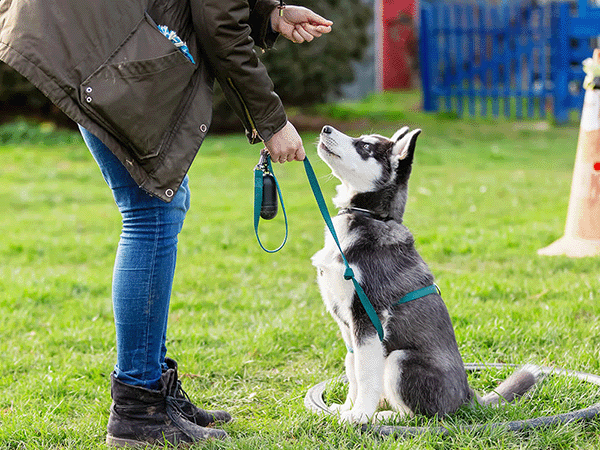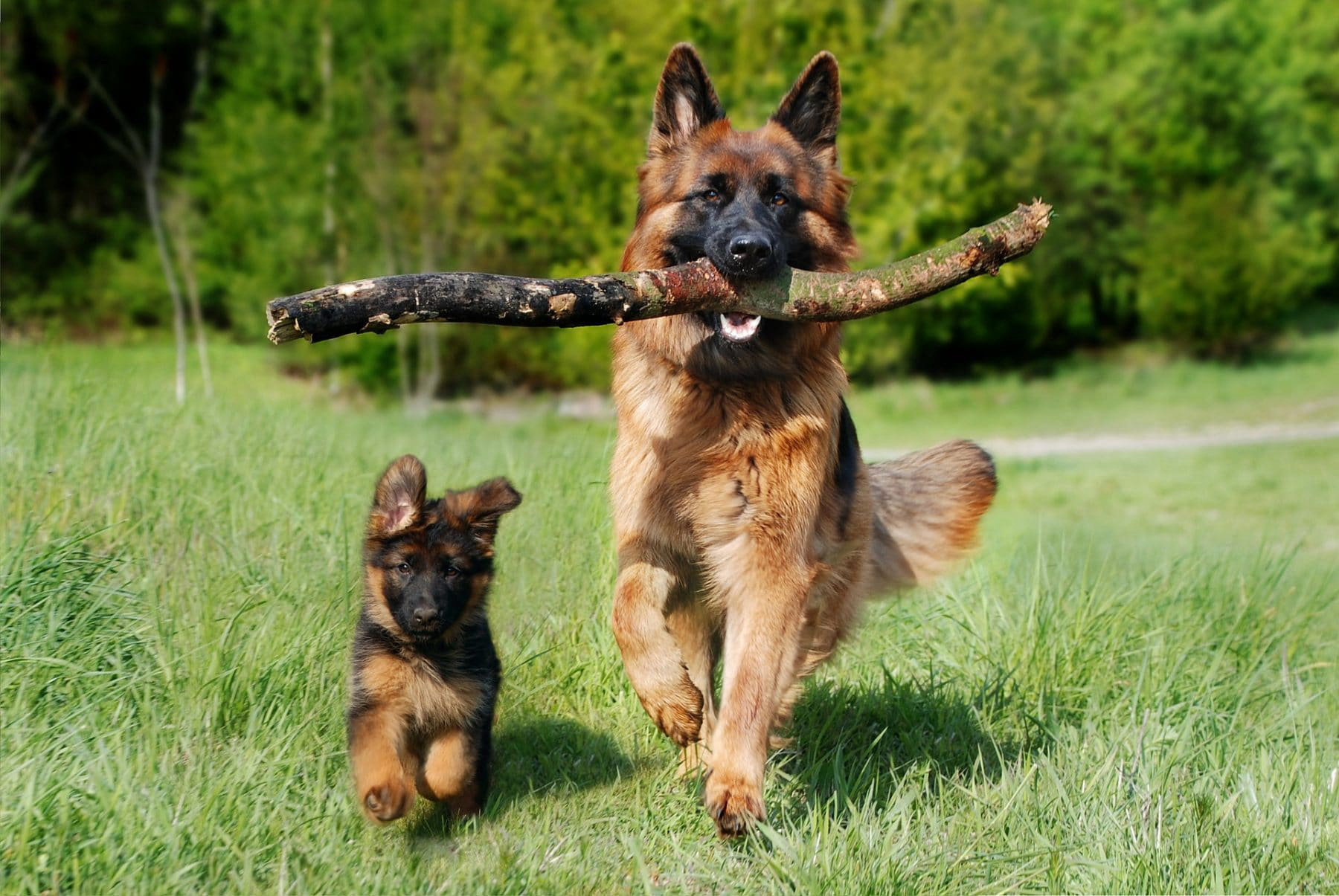How to Train a Deaf Dog

* All Sniffspot articles are reviewed by certified trainers for quality, please see bottom of article for details *
Deaf dogs might require a little extra training time because they aren't able to hear verbal cues and markers from you (or respond to auditory stimuli in the world around you). But there’s no reason to think hearing-impaired dogs can’t be trained just as well as any other dog! All their deafness means means is that you might use different forms of communication than you would with a pup who has perfect hearing.
Here's what you need to know about training a deaf dog. Soon you'll be mastering basic obedience cues, enjoying loose-leash walks, and maybe even dabbling in a dog sport or two.
First: What causes deafness in dogs?
Canine deafness can be caused by any number of things. Some puppies are born deaf — this is called congenital deafness — while others experience an event that causes deafness later in life.
Some dogs are born deaf
Certain breeds are also more likely than others to experience congenital deafness. For example, a dalmation puppy or English setter might be more likely to experience congenital hearing loss than other breeds — but please don’t let that deter you from adopting them! Breed does not guarantee hearing one way or the other, and even deaf dogs make wonderful companion animals. (Some rescue organizations actually specialize in rehoming deaf dogs, spreading the word about how they're often overlooked at other adoption services.)
Deafness in dogs is also often associated with breeding two merle parents (making the puppies double merle) and is one reason ethical breeding practices that don't solely breed for physical appearance/color are imperative.
Other dogs lose their hearing over time
Sometimes an acute event makes a dog go deaf: Anything from infection to exposure to incredibly loud noises can cause hearing loss and even full deafness. Sadly, so can injury and abuse.
Other times dogs, like people, just become deaf over time. Geriatric deafness occurs naturally as dogs get older. Where’s not much you can do to prevent the hearing loss in the first place, you can teach an older dog who’s going deaf to respond to hand signals instead of verbal cues. (This is especially true if they already have a training foundation from their younger years. Turns out you can teach old dogs new tricks!)
Are deaf dogs more aggressive?
Have you heard that dogs who are hard of hearing are more likely to exhibit aggressive behaviors? Good news: You can forget that myth.
While there are certain deaf dog issues that might need to be addressed — especially depending on your individual lifestyle and home environment — with some extra training and attention, you can absolutely help your dog feel comfortable. And when they're comfortable, they'll be able to respond to your cues and exhibit the correct behavior you want.
In short: There really is no correlation between deafness and aggression issues. It's crucial to pay attention to any dog's body language. When you bring home a new dog — whether an adult with full hearing, a deaf puppy, or truly any companion at all — your breeder or adoption organization should work with you to help you understand your individual dog's temperament.
Training a deaf dog is a lot like training a hearing dog
Training a deaf dog is entirely doable. Most general dog training concepts — like those outlined in our Dog Training 101 guide — apply perfectly to deaf dogs. Learning theory remains the same, as does the importance of biological fulfillment (enrichment) and positive reinforcement.
The only real difference is how you communicate with your deaf dog. You might need to make a little extra effort and time for training to lessen the verbal communication gap created by your dog’s hearing loss. But remember: All effective training hinges on patience and time!
Dogs who have hearing issues can also develop other more acute senses. For example, their peripheral vision might become incredibly strong — so while deaf dogs lack the ability to hear you clearly, they sometimes make up for it by excelling in their ability to see you well.

What can you train your deaf dog to do?
You can help your deaf dog with everything from behavior modification (like food aggression or dog reactivity) to basic obedience skills. The sky's the limit the same way it is with a hearing dog: Incompatible behaviors to prevent household problems, impulse-control training work, and more. (Tip: A quick social media search for "deaf dog training videos" will have you feeling inspired in no time.)
How to train a deaf dog
The main difference in training sessions with a deaf dog is that you’re going to use hand signals instead of verbal commands. You’ll also probably rely on eye contact, facial expressions, and even sign language (which can be an advanced form of hand signals) more than you would with a hearing dog. Other than that? As mentioned above, the basic training techniques are very similar!
Some quick tips to start training:
- As with any training scheme, we recommend you have plenty of food for training treats and take things slowly.
- Hours and hours or even days and days of training in a row are a good way to wear your dog out. This can be helpful when they have energy to burn — but you want to be careful not to overdo it and exhaust them!
- Your dog may not even be able to get through an entire training class when they first start.
- To really achieve a happy training experience, keep things simple and short, especially at the beginning.
- Don't rush all your goals at once. There’s always time for additional training later! Deaf dogs these days even go through agility training and other dog sports competitions.
Now for more details on training a deaf dog.
Key point: Visual cues become more important than sounds
When training deaf dogs or puppies, handlers need to rely on the dog’s visual sense and therefore need to use a visual marker (like a thumbs up sign) where you would ordinarily use a verbal marker (like a clicker or "yes"). That means that all your hand and body movements and body postures are crucial because they’ll mean something to the dog so try to pay attention to your body language as you train your dog.
How to get your deaf dog's attention
One of the challenges of deaf dog training is getting their attention. Unlike our canine hearing companions, we can’t use audio or verbal cues or signals as a means of communication. Here are few easy ways to get your deaf dog’s attention:
Vibrations
One easy way to get their attention is via vibrations. For example, stomp or tap on the floor a few times and see if your dog responds. At this stage of training, when they look at you or turn their body towards you, use a little positive reinforcement to show that’s what you wanted them to do and reward them with a treat. Instead of offering verbal praise, use affection to show they’ve done what you wanted them to do. This “check-in” behavior is critical in the training process so it’s clear the dog is engaged in the process.
Light
You can also use light as a visual signal to get your dog’s attention. Use a small flashlight (like a laser pointer — though be aware of possible laser point syndrome depending on your dog's personality) or just flicker your lights gently. Just remember not to shine anything in your dog’s eyes directly!
Many people use this style of training as they would clicker training. The light becomes the reward marker. When the dog exhibits correct behavior, the light is flashed (in this case, giving you attention), offer a little reward to show they’ve done what you wanted them to do.
Other visual signals
Another way to get your deaf dog’s attention and make contact with them is with visual signals. That can be as simple as just waving your arms or hands in front of him or her. Again, when they show a response, acknowledge it with food treats or even a little hug if your dog finds hugging reinforcing. When they exhibit a correct response, you can also use a finger flash where you just open and close your hand from a fist to “jazz hands” over and over again. In time, they’ll come to recognize that this kind of visual hand flash marker means they’ve done something right.
Avoid startling your deaf dog!
Whatever you do, try not to startle them. Approaching a deaf dog from behind to get their attention can feel very threatening to a dog who can’t hear you coming. For this reason, it’s a good idea to practice tapping them on the shoulder or even giving them a little pet on the tushy and then offering a treat when they turn around. Over time, they’ll learn that a tap on the shoulder isn’t such a bad thing.
Tether training can also help avoid startling your dog. In this approach, you keep your deaf dog attached to you via a leash for the initial training period, which allows you to communicate quickly regarding behaviors you do and do not like — and for them to get used to your natural range of movements. You can build a stronger relationship based on positive association through training like this!
Use vibration collars with care
If all else fails, you can always try using a vibrating collar — not a shock collar that hurts the dog when it’s done something wrong. Instead of using any electrical impulse, a vibrating collar tells the dog you need their attention. All you need to do is make the collar vibrate when you want the dog’s attention and then offer a treat when the dog turns their head your way. Some pet parents choose to condition these collars like clicker training tools where the vibration functions as the reward marker.
Hand signals and sign language
A great technique when it comes to deaf dog training is to use hand signals. With hearing dogs, we usually use verbal communication to get them to learn “sit,” “stay,” “heel,” etc., but with dogs who have experienced hearing loss, we need to figure out another way to get them to exhibit the behavior we’re looking for. One way to do that is with hand signals. You can create your own hand signals to use when you want the dog to respond to a certain command and you can use gestures with voice commands so that it feels natural for you. It really doesn’t matter that the dog can’t hear you.
You can learn more about using hand signals with your dog in this article.
Use sign language
As we said above, you can create your own “vocabulary” of obedience hand signals for these and other commands, or you can use the hand signals used in human sign language (otherwise known as American Sign Language or ASL) for these commands. Sign language is actually a great communication tool in general for deaf dogs, in part because it standardizes their training so someone other than you who knows those signals can lead the dog.
The importance of eye contact
A key point when you’re training a dog who has been affected by deafness, is to make sure your dog is making eye contact with you. Since you can’t use verbal or audio cues, it’s crucial that your dog is paying attention to your visual cues and hand signals, so whenever your deaf dog makes direct eye contact, make sure you acknowledge it.
Safety tips to keep in mind
Always keep your deaf dog on a leash while training
Make sure you keep your deaf dog on a leash while training. Unlike hearing dogs, deaf dogs cannot respond to a verbal command emergency recall. For that reason, it’s crucial you have a way to pull them back if they suddenly run away from you or worse, start to run out into the street. Also, if their back is to you, there is no way to give obedience hand signals or use another form of communication to alert them to danger.
Deaf dogs can become training superstars!
The bond between people and their dogs is a strong one and deafness does nothing to diminish that. A deaf dog’s daily life can be just as rewarding and happy as any other dog. Don’t be intimidated by the task in front of you!
With positive reinforcement training involving few hand signals, great eye contact, and a little patience, your deaf dog will be just as well trained as any hearing dog.
Need more resources? Deaf Dogs Rock is a non-profit organization dedicated to showing the world how incredible deaf dogs can be — and making it easier for pet parents to work with their hearing-impaired companions. Other public charities supporting deaf dogs include Deaf Dog Rescue of America and various local organizations; don't be shy about reaching out to shelters and reward-based training centers in your area!
Trainer Review of this Article
There is so much misinformation out there, we want to make sure we only provide the highest quality information to our community. We have all of our articles reviewed by qualified, positive-only trainers.
This is the trainer that reviewed this article:
Shannon Finch
AnimalKind Training
M.Ed. Humane Education
Karen Pryor Academy Certified Training Partner
Certified Tellington TTouch and TTEAM Practitioner
Most recent articles

What Is a Reactive Dog? A Complete Guide
Is your dog overly excited or fearful around other dogs? Do they bark, lunge, or whine? You might have a reactive dog. Many dog owners face this challenge. Understanding what a reactive dog is is the first step to helping them. This guide explores the common causes of dog reactivity, explains what makes a dog reactive, and offers practical tips and resources. Let's work together to build a stronger bond with your dog and enjoy stress-free walks.

Positive Dog Body Language: Signs of a Happy Pup
* All Sniffspot articles are reviewed by certified trainers for quality, please see bottom of article for details *

Best Dog Parks Near Me in Austin (Public & Private)
Looking for the perfect dog park near me in Austin? This guide has you covered. We'll explore Austin's best dog parks, from Zilker Park's popular off-leash area to smaller, quieter options. Plus, we'll introduce you to Sniffspot, where you can rent private dog parks near me. Let's find the perfect spot for your furry friend!

Shih Tzu Ownership: Ultimate Guide for New Owners
So, you're thinking about adding a Shih Tzu to your family? Excellent choice! These pups are known for their affectionate personalities and gorgeous coats. But before you bring one home, let's cover some essential shih tzu advice for new owners. This guide, created with insights from experienced Shih Tzu owners, will help you prepare. We'll explore everything from whether Shih Tzus are loyal and affectionate, to if they can be service dogs. Plus, we'll share practical tips on training, grooming, and health. Ready to become a Shih Tzu expert? Let's go!

Dog Parks Near Me: Chicago Guide (Public & Private)
Finding the perfect dog park near me in Chicago can feel overwhelming. But don't worry! This guide explores Chicago's best dog-friendly spots, from popular public dog parks near me to private Sniffspot Chicago locations. We'll cover everything you need for a safe and fun outing, including a handy checklist and tips on dog park etiquette. Whether you want a quick walk, a chance for your pup to socialize, or the best off-leash dog park experience, we've got the perfect spot for you and your furry friend.
Related articles
Top dog guides per area
Dog training guides

Dog Food Aggression: Why You Shouldn't Punish It
Does your dog ever growl when you walk by their food dish? Maybe they get possessive of treats, carrying them far away and giving you side-eye when you start to approach — or snarling at your other pets or children if they get too close.

Scent Training for Dogs: A Beginner's Guide
As almost every dog owner is aware, the nose of a dog is an amazing thing. Just as they can pick up sounds we can’t hear, their sense of smell and ability to pick up scents is well beyond ours. In fact, dogs have 40 times the number of olfactory receptors as humans.

Service Dog Training Costs: DIY vs. Pro
More than 80 million Americans rely on their service dogs to help them navigate the world. Task-trained assistance animals perform a huge range of life-changing—in many cases, life-saving—services: These dogs act as eyes for visually impaired handlers, provide mobility support, alert to seizures and blood sugar crashes, interrupt anxiety attacks, remind their people to take medications, and so much more.

How to Deal With Puppy Potty Training Regression
You thought those dreaded middle-of-the-night potty breaks were over. You were finally free from cleaning up puppy puddles. Then, suddenly, your furry friend starts having accidents again. It's frustrating, right? This puppy potty training regression is more common than you think. Don't worry; we'll help you get your pup back on track. We'll cover the common causes, offer practical solutions, and give you actionable steps to tackle this challenge together.

Dirty Dog Syndrome: Causes, Solutions, and Prevention
It's a cringe-worthy moment every dog owner dreads: your furry friend chowing down on something truly disgusting. If your dog has a penchant for poop, you're dealing with coprophagia. It's more common than you think, and thankfully, often manageable. This article explores the reasons behind dirty dog syndrome, from instinct to learned behavior. We'll also give you practical tips to help break this unpleasant habit.
Dog enrichment guides

Top 10 Dog Water Parks in the US
Do you have a water-loving dog looking to burn some energy? There are countless dog parks to visit throughout our country — but some of them become far too hot in the midday sun to be safe for your pets to play. That’s why we’ve put together a list of some of the best dog water parks throughout the United States! At these locations, your pup can frolic, splash, and swim to their heart’s content.

Best Toys for Herding Dogs: Keeping Your Pup Happy & Engaged
Herding dogs are amazing, intelligent companions. But that also means they need more than just a simple game of fetch. Finding the right toys for herding dogs is key to keeping them happy and stimulated. This article explores some of the best toys for herding dogs, including options specifically for breeds like Border Collies and Australian Shepherds. We'll help you discover the perfect herding toys for dogs to tap into their natural instincts and keep them entertained for hours.

Ultimate Guide: Dog Toys for Aggressive Chewers
Does your dog destroy every toy you give them? Is your house littered with remnants of fabric and stuffing of all different sizes? Are you tired of investing in “indestructible” toys only for your pup to still dismantle—or worse, get bored of—them in just a few days?

Daily Exercise Calculator: How Much Exercise Does Your Dog Need?
Everyone knows dogs need exercise, but how much is enough? Walks are great, but creating a truly balanced fitness plan means understanding your dog's specific needs. This post helps you develop a daily exercise calculator for your dog, considering breed, age, and lifestyle. We'll cover fun activities, understanding exercise intensity, and recognizing when your pup has had enough. Let's create a plan that keeps your dog happy and healthy!

Complete Guide To Herding With Dogs
* All Sniffspot articles are reviewed by certified trainers for quality, please see bottom of article for details *
Dog reactivity guides

Rottweiler Aggression: Truth vs. Myth
Many dogs have gotten a bad reputation over the years for being "dangerous breeds." Rottweilers are among them. Like pit bulls and other large, blocky-headed types of dogs, these powerful and beautiful animals are often assumed to be aggressive.

What Is a Reactive Dog? A Practical Guide for Owners
Does your dog suddenly transform into a barking, lunging Tasmanian devil on walks? It's stressful for both of you. If this sounds familiar, you might have a reactive dog. Understanding what is a reactive dog is the first step to calmer walks. We'll explore the common triggers and give you actionable strategies to manage and modify this behavior. Let's turn those stressful walks into enjoyable outings.

How to Socialize a Reactive Dog: A Step-by-Step Guide
Does your dog display reactivity to other pets or people? Maybe they’re a new rescue pup and are still settling into your home. Or they were sick growing up, so you missed their critical socialization period. Possibly they’ve had a bad experience after being raised as a normal puppy.

What Is a Reactive Dog? A Complete Guide
Is your dog overly excited or fearful around other dogs? Do they bark, lunge, or whine? You might have a reactive dog. Many dog owners face this challenge. Understanding what a reactive dog is is the first step to helping them. This guide explores the common causes of dog reactivity, explains what makes a dog reactive, and offers practical tips and resources. Let's work together to build a stronger bond with your dog and enjoy stress-free walks.

Best Online Dog Training for Reactive Dogs: A Practical Guide
Does your dog's reactivity make walks stressful? You're not alone. Many dog owners face similar challenges. This guide offers practical advice and support for managing reactivity, including finding the best online dog training for reactive dogs. We'll connect you with reactive dog support groups, share training tips, and explore resources like the best dog training app for reactive dogs. Let's build a stronger bond with your dog, together.
* All Sniffspot articles are reviewed by certified trainers for quality, please see bottom of article for details *
Sniffspot community guides

The State of Public Dog Parks Across the United States
From 2009 to 2020, there was a 40 percent increase in the development of public dog parks. Designated spots for canine exercise have become commonplace in every major city in North America — many pet owners won’t even consider renting an apartment that doesn’t have its own fenced-in pet area for their canine companions.

How This Family is Affording Their Dream Property Through Renting it Hourly to Dogs
Thousand Oaks, California has been a safe haven for Sniffspot host, Jen, since childhood. Having grown up in busy Santa Barbara, Jen, an introvert from an early age, would seek out solitude and serenity away from tourists attractions and droves of people visiting from elsewhere. “My grandparents own 60 acres about a 30 minute drive from here, and I grew up spending every summer and every holiday visiting them on the ranch,” Jen explained. “In Santa Barbara, we wouldn't go to the beach on the weekend because that's where everybody was, so you'd find places off the beaten path where the tourists weren't. For me, the ranch was just my happy place.”

Host Tips: Ellen K. What Makes Sniffspot Successful for Me
Ellen is the host of Country Pasture Getaway, one of Sniffspot's most popular sniff spots. She has taken the time to write up the lessons she has learned about how to be a great sniff spot host.

How this Oregon Farmer is Making a Business From Renting Her Land to Dogs
Just 20 minutes outside of the busy city of Portland, Oregon, and settled right on the banks of the Columbia River, you’ll find what countless visitors have flocked to the area in search of – mountain views, crisp, clean air, and running water for miles. What you might not expect to find, however, is a hidden oasis designed just for dogs and their people, owned and operated by a farming couple and enjoyed by visitors on two legs, and four.

Host Tips: Fran T. Providing Great Guest Service at our Spot
Fran is the host of Ranch Setting, one of Sniffspot's most popular spots. She has taken the time to write up the lessons she has learned about how to be a great Sniffspot host.
Top dog trainers in the US

The Best Dog Trainers in the United States of 2025
This is a list of the top dog trainers in the United States, based on votes from the Sniffspot community and the general public.
The Best Dog Trainers in Seattle, WA of 2025
This is a list of the top dog trainers in Seattle, WA, based on votes from the Sniffspot community and the general public.
The Best Dog Trainers in Portland, OR of 2025
This is a list of the top dog trainers in Portland, OR, based on votes from the Sniffspot community and the general public.
The Best Dog Trainers in Los Angeles, CA of 2025
This is a list of the top dog trainers in Los Angeles, CA, based on votes from the Sniffspot community and the general public.
The Best Dog Trainers in New York, NY of 2025
This is a list of the top dog trainers in New York, NY, based on votes from the Sniffspot community and the general public.
City dog parks guides

Top 10 Indoor Dog Parks: A US Guide
Looking for a space to play with your dog no matter what the weather’s like outside? Look no further than our list of the best indoor dog parks in the United States! These climate-controlled spaces are growing in popularity as pet ownership increases throughout the country. As a bonus, many of them also offer dog training, boarding, grooming, or daycare services on the premises.

15 Best Dog Parks in the US: Public & Private
Searching for the best off-leash dog parks near you in the United States? Whether you're looking for public dog parks with open spaces or private, fully-fenced areas, this comprehensive guide has you covered. Discover top-rated parks across the country, plus essential tips on what to bring and what to expect for your next adventure.

Dog Parks Near Me: Las Vegas Edition
Looking for the perfect dog park near me in Las Vegas? You're in luck! This guide explores all the best options for your pup, from public dog parks to private dog parks near me on Sniffspot. We'll help you find the ideal spot for playtime, socializing, and fresh air. Plus, we'll cover essential etiquette and safety tips to ensure a happy visit for everyone. Get ready for some tail-wagging fun!

Best Sniffspot Locations: Private Dog Parks Near You
Looking for the perfect dog park? Whether you need a wide-open public space or a private, fenced-in spot, this guide will help you find the best dog parks across the US. We'll cover top-rated public parks, the perks of private dog parks, and even explore Sniffspot locations – giving your pup a safe and fun place to play. Ready to find your dog's new favorite spot? Let's go!

Sniffspot: Portland's Best Private Dog Parks
Ready to discover Portland's best dog parks? Whether you're looking for a public park or the unique experience of a private Sniffspot, this guide has you covered. We'll help you find the perfect spot for your pup, with tips on what to bring, how to prepare, and even understanding dog body language. Plus, we'll explore some top Portland dog parks, including public and Sniffspot options, so you can plan your next dog-friendly adventure in the City of Roses.
Dogs breeds

German Shepherd Dog: Breed Facts, Experience and Tips from 9K+ Owners
Discover the German Shepherd Dog, a breed celebrated for its intelligence, loyalty, and versatility. Known for its impressive size and smooth, graceful movements, German Shepherds excel in various roles, including as guide, therapy, bomb detection, and police dogs, while being a devoted family companion.

Labrador Retriever: Breed Facts, Experience and Tips from 9K+ Owners
Discover the Labrador Retriever, a breed celebrated for its playful nature, affectionate temperament, and trainability. Labradors are known for their friendly demeanor and adaptability, making them perfect family companions and versatile working dogs. As one of the most popular types of retrievers, Labs are ideal companions for various lifestyles and are recognized by the American Kennel Club (AKC) as an excellent breed for families.

Golden Retriever: Breed Facts, Experience and Tips from 9K+ Owners
Discover the Golden Retriever, a popular breed celebrated for its affectionate, playful, and trainable nature. Considered a large dog, Golden Retrievers were originally bred in Scotland for hunting and retrieving game beginning in the 1860s. Today, they're recognized by the Kennel Club and the American Kennel Club (AKC) as one of the most beloved companion dog breeds.

American Staffordshire Terrier: Your Complete Guide
Think American Staffordshire Terriers are tough? Think again. While their muscular build might intimidate some, these dogs are known for their playful and loyal personalities. This guide draws on the experience of nearly 10,000 AmStaff owners to reveal the truth about this often misunderstood breed. Want to learn more about caring for an American Staffordshire Terrier? You're in the right place.

Australian Shepherd Facts: Breed Info & Care Guide
Discover the Australian Shepherd, an AKC breed celebrated for its trainable, playful, and affectionate nature. Despite its name, the Australian Shepherd is actually a native breed to the United States, originally developed to breed on farms and ranches. Considered a medium dog, Australian Shepherds were bred for herding beginning in the 1950s. As one of the high-energy breeds, Aussies are known for their boundless energy and need for regular exercise, including aerobic exercise.
Top dog names in the US

Top 1,000 Most Popular Dog Names
Looking for the perfect dog name for your new pup? We have created filterable lists of dog names from our database of hundreds of thousands of Sniffspot users. You can filter by gender, breed and state to find the most cute, unique and creative dog names.
Most Popular Male Dog Names
Looking for the perfect dog name for your new male pup? We have created filterable lists of male dog names from our database of hundreds of thousands of Sniffspot users. You can filter by gender, breed and state to find the most cute, unique and creative male dog names.
Most Popular Female Dog Names
Looking for the perfect dog name for your new female pup? We have created filterable lists of female dog names from our database of hundreds of thousands of Sniffspot users. You can filter by gender, breed and state to find the most cute, unique and creative female dog names.
Most Popular Golden Retriever Names
Welcome to our comprehensive list of Golden Retriever dog names, curated from our vast database of Sniffspot users. Filter through hundreds of thousands of options by gender, breed, and state to discover the most adorable, original, and imaginative names for your beloved Golden Retriever.
Most Popular Labrador Retriever Names
Welcome to our Labrador Retriever dog names page! Here you can browse through filterable lists of names for your beloved furry friend, ranging from cute and classic to unique and creative options. Our database of hundreds of thousands of Sniffspot users ensures you'll find the perfect name for your Labrador Retriever, whether you're seeking a name for a male or female, based on breed or state.
Top dog rescues in the US

The Best Washington Dog Rescues & Shelters in 2025
This list showcases the top dog rescues & shelters in Washington. These remarkable organizations have been recognized for their unwavering dedication to the well-being of countless dogs.
The Best Oregon Dog Rescues & Shelters in 2025
This list showcases the top dog rescues & shelters in Oregon. These remarkable organizations have been recognized for their unwavering dedication to the well-being of countless dogs.
The Best California Dog Rescues & Shelters in 2025
This list showcases the top dog rescues & shelters in California. These remarkable organizations have been recognized for their unwavering dedication to the well-being of countless dogs.
The Best Florida Dog Rescues & Shelters in 2025
This list showcases the top dog rescues & shelters in Florida. These remarkable organizations have been recognized for their unwavering dedication to the well-being of countless dogs.
The Best New York Dog Rescues & Shelters in 2025
This list showcases the top dog rescues & shelters in New York. These remarkable organizations have been recognized for their unwavering dedication to the well-being of countless dogs.






















